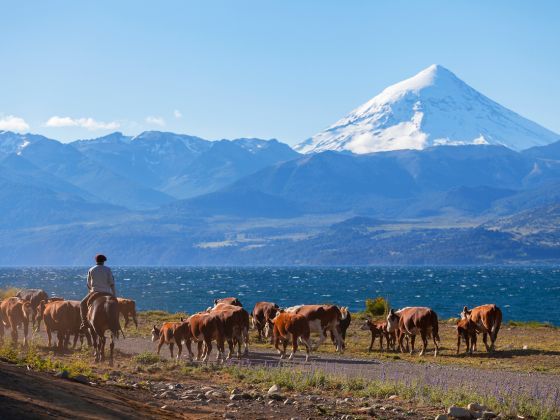My relationship with Patagonia began in 2006: a road trip from Buenos Aires guided by my father-in-law Adalberto. As someone who has been exploring the region since he was a little boy growing up in the province of Neuquén — in a time where the only way through the cordillera was on horseback — he was able to provide a rare perspective on the cultures, towns, rivers, and wildlife of southern Argentina.
Two seemingly contradictory things were really impressed upon me in this initial trip. One was the outright scale-shattering presence of the terrain. But the other was that no matter how deep you were into the massive landscape, you’d find people living there. There were paisanos, (a non-derogatory colloquialism for camepsino or “country folk”) scratching out a living on small isolated ranches. Refugieros, or shelter-keepers, with their home-brewed beer and herds of sheep on some high mountain aerie. Indigenous Mapuche living in small, self-sufficient homesteads (complete with small wind-driven power supplies) deep in the national parks.
What I learned was that far from empty, Patagonia is a peopled landscape. And that while perhaps in the US one associated wilderness with national forests and parks, places to visit but not live, something about this seemed grounded and real, inspiring.
My trips to the region left a strong sense of what could be possible, travel- and life-wise, if we could ever figure out how to move to Patagonia for an extended time. Then in 2010, when our first child was just two years old, we decided to give it a shot and moved to the small town of El Bolsón.
The following descriptions collect some of the most important lessons we learned living in Patagonia.
1. Most of us have never seen water as it’s intended to be.
As a kayaker, I simply couldn’t get over the water in Patagonia. My home river there, the Rio Azul, is fully potable, meaning when you get thirsty you can just cup your hand in the river and drink. This is still true throughout much of Patagonia. The water color, clarity, purity is both astounding and somewhat saddening: You realize how badly most watersheds around the world have been impacted. You also realize it’s not something to take for granted. Large-scale hydroelectric projects proposed throughout the region continue to threaten the healthy ecosystems.
2. Gauchos could continue to survive long after everything else disappears.
Whereas many of gauchos’ worldwide counterparts—such as US cowboys—have modernized their lifestyles, often working via trucks as opposed to horseback, gauchos throughout Patagonia (and especially across the pampas) have retained their traditional ways of life, herding sheep or cows, and working large farms or estancias.
3. It’s really far south.
Most people don’t realize how far south Patagonia is. In Argentina it’s simply known as “El Sur.” The extreme austral environment creates a habitat for Magellanic penguins, elephant seals, and other marine mammals and birds making epic migrations each year.
4. Most “shelters” could take a lesson from here.
Consider the shelter on Cerro Piltriquitron. As with many shelters throughout Patagonia, these places may be a full day’s horseback ride from the town, but they have caretakers year round living (and serving guests) in a crazy style that seems a hybrid of Argentine hospitality with European cuisine and alpine guest-house traditions. Somehow this was lost on us in the US. Fresh lamb, trout, local beef, vegetables, home-brewed beer, homemade pizza—when you reach these refugios after all-day backcountry treks, it seems almost like you’re in heaven.
5. Some roads redefine your sense of “empty.”
Although the Ruta 40 through the provinces of Chubut and Santa Cruz is the most iconic, dozens of “highways” (typically narrow, shoulderless, rough caminos de ripio or gravel roads) in Patagonia have the same effect: You become absolutely dwarfed by the landscape. This can be at turns both thrilling and intimidating. On our first road trip along the Atlantic coast, I drove an empty coastline for literally hours without seeing anyone or anything besides guanacos and rabbits.
6. The snow terrain can be epic.
While most of the classic Andean ski areas are lower elevation/warmer temperature than other parts of the world (thus meaning a heavier, less powdery snow), it’s still some of the most fun snowboarding I’ve ever done. Everything is still waiting “to be done.”
7. Por hacer.
There’s a saying in Spanish that something is still “por hacer,” or waiting to be done. That’s how Patagonia is. Unlike places in the US and especially in Europe, this is a particularly young landscape with an extremely sparse population. Meaning outdoor objectives, explorations and adventures of all kinds, are still waiting to be pioneered. It’s exciting.
8. You can watch birds fly from horizon to horizon —minutes at a time— and never flap their wings.
Patagonia is habitat to the Andean Condor. It’s not the birds’ size which is so spectacular (although condors are among the birds with the largest wingspan on earth, up to 10.5 feet) but the way they’ve evolved to their specific habitat. The Andean Cordillera is a terrain of steep alpine ridges that regularly produce thermal columns upon which condors can glide seemingly forever without flapping their wings.
Once, while I was snowboarding at La Hoya in Esquel, a lone condor floated a hundred or so feet above the slope, riding upwards seemingly parallel with the chairlift, rising almost motionlessly over the skiers and boarders below. What was he doing there? What food source or reason could he possibly have had over a ski run? It seemed almost as if he was schooling everyone, showing what real flow looked like. Many people noticed the condor; you could see heads turning and people stopping and pointing upwards. It was a strange, almost indescribably serene moment, although strangely fitting, not out of place in Patagonia.

